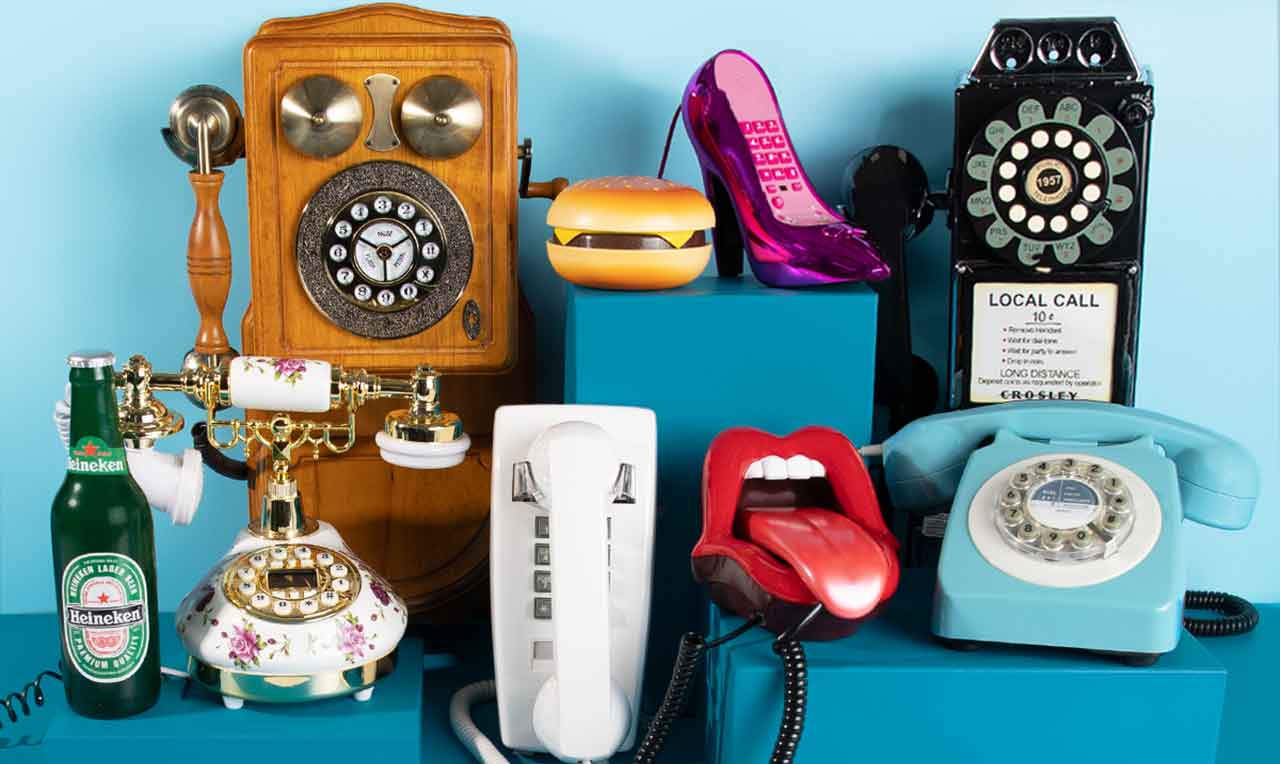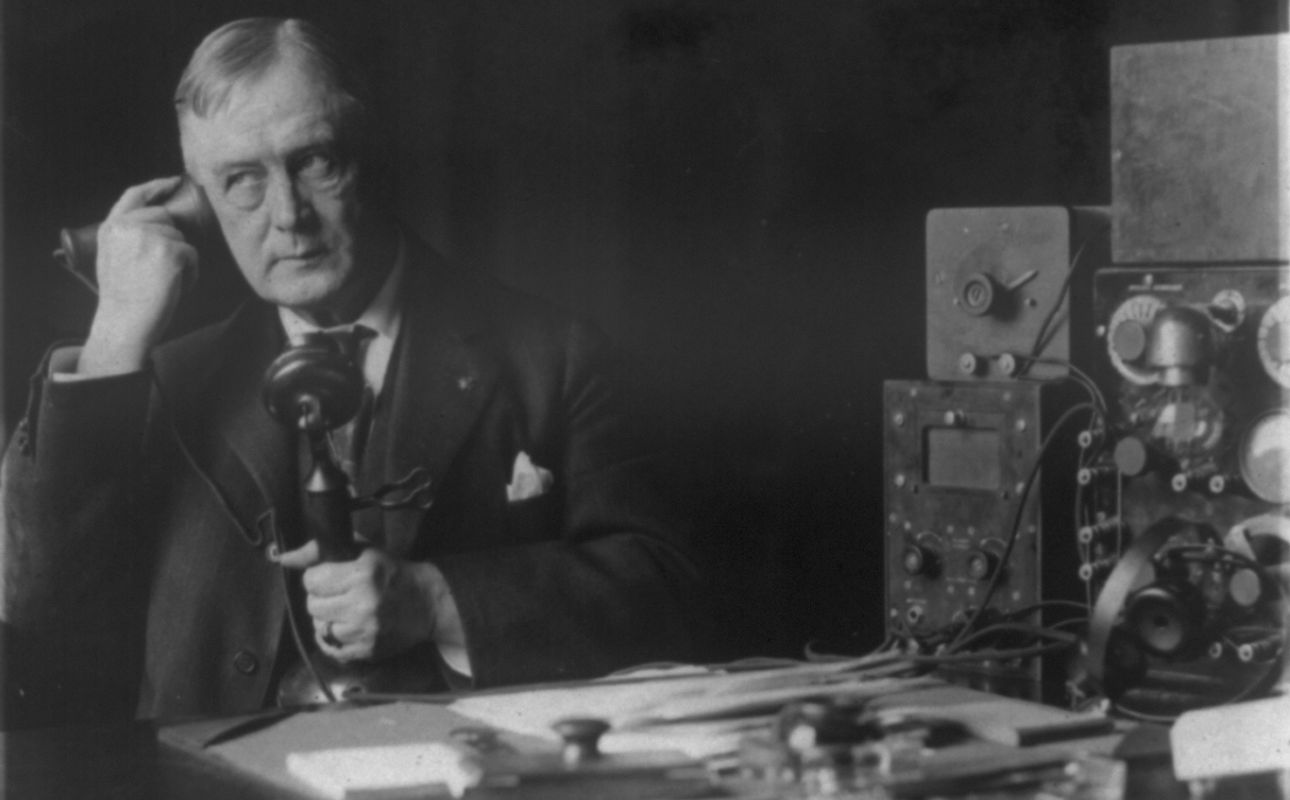Celebrating National Telephone Day: from string phones to cell phones and beyond

April 25th is National Telephone Day, a perfect time to reminisce about the history of the telephone, a technology that has reshaped civilization.
The telephone is so integral to our lives that it’s difficult to imagine living without it, although when the first phone was invented, many people thought it was unnecessary because the telegraph was already able to send a message. Today, of course, just about everyone carries a smartphone. While text messaging, like the telegraph, is an important component of communication, there’s no denying the power and importance of voice.
Think about the basics: how we begin a conversation on the telephone. Some folks might say, “What’s up?” or “Hey!” but it’s a fair bet that no one says, “Ahoy!” This sounds more like a shipboard welcome. Yet if Alexander Graham Bell’s initial telephone greeting idea had prevailed, we might still be answering the phone with “Ahoy!” today. Fortunately, his contemporary Thomas Edison offered “Hello” as an alternative, and this greeting became the standard.
Celebrate National Telephone Day with a telephone timeline

Paste this Image on Your Site!
Simply copy and paste the code below and you can share this infographic on your site:
The 1600s
Our telephone timeline begins way back in the 1600s. Yes, we usually think about the 19th century but early iterations of the phone were actually created several centuries prior. For instance, during the Renaissance, a polymath instrument maker named Robert Hooke discovered that sound could be transmitted via wire, thus inventing the first, primitive, acoustic telephone in 1672. He called it an ear trumpet.
The 1800s
This is likely where most people’s knowledge on the history of the phone begins. In 1876, Alexander Graham Bell created a short-range telephone. Many inventors were working on similar devices at the same time, but because Bell was the first to patent the invention, his milestone is often cited as the genesis of the telephone.
On a personal level, Bell seems singularly suited to be the acknowledged father of the modern telephone: his own father, uncle, and grandfather were all skilled elocutionists, and his father encouraged young Alexander’s interest in speech. In addition, both Bell’s mother and his wife were deaf. This background profoundly influenced his life work with sound.
Once Bell received his patent, telephone development accelerated swiftly. Just over a year later, in 1877, Bell founded the Bell Telephone Company and the first residential telephone line was laid from Boston to Somerville, Massachusetts. In 1878, the first commercial telephone exchange in North America opened in New Haven, Connecticut. This was an important shift, because communication technology was becoming communication infrastructure.
1900-1959
The first transcontinental telephone call took place between San Francisco and New York City in 1915, demonstrating that calls could be made across long distances. Automated calling was also in development. Initially, an operator would connect callers, but in 1919, rotary phones were introduced into the Bell system, allowing callers to dial telephone numbers themselves.
Then in 1927, the device design got an upgrade: a telephone handset that combined talking and listening components. Developers continued to push the limits of long-distance calls, and in 1935, the first telephone call was routed around the world via wire and radio. More than a decade later, in 1947, the telephone area code system was developed for North America.
1960-1979
In 1961, direct long-distance calls became available nationwide. This meant an operator was no longer needed to call long distance.
Another design upgrade came in 1963. The first push-button telephone was developed, allowing Touch-Tone dialing. Two years later, phone design got even more streamlined with the classic Trimline telephone model. Changes were also made to improve consumer safety and convenience. In 1968, the first 911 call was made in Alabama. The introduction of 911 enabled callers to rely on a single, three-digit number for any type of emergency, rather than having to memorize different local phone numbers for police, fire and hospitals.
Also during the 1970s, party lines began to be phased out in favor of single lines per household, cutting way down on neighborhood gossip—or at least foiling its ease of access.
1980-1999
The 1980s introduced wireless calling. First, cordless phones freed callers from being connected to the wall when using their landlines. Cellular phone technology was also being developed.
Cell phone history evolved much more rapidly than telephones overall. In 1984, the first commercially available mobile phone became available. But, just as with most technological inventions that become smaller and less expensive over time, early cell phones were nothing like what we use today! The initial cell phone on the market cost $4,000, weighed 1.75 pounds, and had 30 minutes of talk time.
Answering machines were the next big innovation, and in 1991, two out of five homes had them, at a cost of $50 to $250 per machine. Also in 1991, call waiting began to gain popularity. Before that, you got a busy signal. By 1993, Caller ID was available in 37 states and parts of New York City.
Public payphones peaked at 2.6 million during the mid-1990s at the tipping point when cell phones were starting to gain traction. In 1995, the U.S. had 33.8 million cell phone subscribers, and text messaging was made possible by hitting each number multiple times to get the right letter, a method called T9. Cell phones continued to get smaller and lighter, and in 1996, flip phones like the Motorola StarTAC—and eventually, the Razr—were popular.
2000-2019
As the new millennium dawned, there were 109.5 million cellular phone subscribers. Mobile phones also started to get smart in 2000, with the rise of personal digital assistants (PDAs) like the Handspring VisorPhone and PalmPilot. In 2004, BlackBerry added full Web browsing capabilities to its functionality.
In 2007, the first iPhone made its debut, costing $600. There was quickly a frenzy for iPhones, and people lined up for days to get one. One buyer told Macworld at the time, “Today, I’ve got three things in my pocket,” referencing his iPod, PDA and cell phone. “Tomorrow, I’ll have one,” he added.
The first-generation iPhone was lauded for its sleek design and intuitive touchscreen. However, not everyone was on board. Wired’s review commented about the cell phone’s cost, saying that it “isn’t worth the money,” and Blackberry fans ridiculed its lack of a physical keyboard.
Nevertheless, the launch of the iPhone paved the way to our current smartphone era. In 2013, smartphones overtook “dumb” phone sales worldwide. Android devices were popular with 52 percent of smartphone subscribers in 2013 using the platform, 38 percent using iOS, and the remainder using another platform.
Since a cell phone stores all your contacts, there was no longer a need to memorize phone numbers. However, we tend to memorize phone numbers we call frequently without even trying. A 2023 Ooma survey found that the vast majority of respondents have at least five phone numbers memorized. Typically, numbers for a home phone, spouse or significant other, parents, kids or grandchildren, and other family members rank highest, followed by work and best friends.
As more people carried cell phones, payphones became less and less necessary as well. In 2014, fewer than 300,000 pay phones remained, and creative repurposing projects have converted phone booths into tiny art galleries, information booths and Wi-Fi® routers. By 2017, 95 percent of Americans owned a mobile phone.
Cell phones are a literal gold mine—and not just for telecommunications companies. There are approximately 0.034 grams of gold in your smartphone, connecting the integrated circuits in the motherboard. These chips require highly reliable materials that won’t corrode or impair the device’s functionality over time, and as a precious metal, gold makes for better conductivity and resistance to damage. A 2019 World Economic Forum report states that a ton of mobile phones contains more than 100 times the amount of gold found in a ton of gold ore.
2020-2024
Because of COVID-19, phone calls gained a new, critical importance in keeping people connected. Providers saw the average call volume skyrocket and length of calls increase. Phone calls became a familiar touchstone amid social distancing, lack of gatherings, and concerns about well-being.
Providers saw the average call volume skyrocket and length of calls increase. Phone calls became a familiar touchstone amid social distancing, lack of gatherings, and concerns about well-being.
Beyond the spike in personal phone calls, there was also a growing shift to using phone calls in the workplace to combat nonstop videoconferencing and Zoom fatigue. The Wall Street Journal called it a “phone call renaissance.”
2025 and beyond: what the future holds
While it seems as though many people are using their cell phones day and night, you might be amazed to learn just how much time we do spend on our phones. Statista reported in a 2024 study that people aged 18 to 34 spend an more than 40 hours a week on their phones. That’s not just counting phone calls, but Web browsing, social media, messaging apps, games and more.
Now that we’re connected 24/7, it was inevitable that there’d be nostalgia for the early days of telephone use—and the early phones themselves. Retro phones, like old movies, have committed fans that adore creative looks such as the vintage cheeseburger phone. You can enjoy delicious conversations for zero calories!
What will our cell phones look like in decades to come? Technology innovators say they’ll continue to integrate into our lives just as cars have. We’ve already reconfigured our lives so that our devices are a natural extension of our appendages. Some makers predict the decline of apps, or the rise of the foldable smartphone, because, yes, technological inventions tend to shrink in size over time.
One thing we’ve learned in looking at the history of the phone: The telephone, no matter what form it takes, is clearly here to stay. Happy National Telephone Day!



